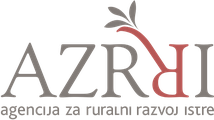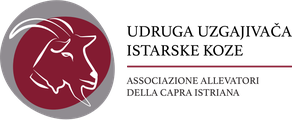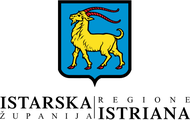About the breed
The Istrian goat, like other indigenous breeds of Istria, is a unique genetic heritage crafted over thousands of years with the toil and skills of Istrian peasants, making it somewhat original and irreplaceable.
For centuries, it has been bred for milk production and perceived as a "small cow for the poor." Adaptability to harsh conditions, modest food requirements, and a propensity for high fertility were considered its main advantages over other domestic animal species.
The Istrian goat is a unique breed, genetically distinct from other European white breeds with which it shares external similarities. It has a large body frame, robust but not coarse constitution, slightly accentuated bones, fundamentally white in color with possible grayish and/or cream shades, and the appearance of gray pigment on the skin in the form of dots or patches, most commonly on the tip of the muzzle, inner side of the ears, and udder. Additionally, a characteristic of the breed is the presence of beards in males and females, as well as horns and tassels. A distinctive feature of the appearance of mature, older bucks are long, rough, heavy, and wrinkled horns directed backward and to the side, with a span between the tips of up to one meter.
The Istrian goat has survived and endured numerous wars, diseases, and other adversities, faithfully following its master and aiding in survival. Thus, the Istrian breed had not only an economic but also a nutritional role; it was a healer and savior, with its milk being medicine, and it had social, cultural, sociological, and demographic significance. It survived the infamous epithet of "pest" imposed and enforced by various authorities that ruled over Istria, and today, it is necessary for managing the environment around our settlements and preserving the biodiversity of the Istrian peninsula.
Throughout the centuries, the Istrian goat has been a recognizable heraldic symbol of Istria and remains present in the coat of arms of the Istrian County and the Republic of Croatia to this day, but in its real form, it has almost disappeared from breeding areas. Unfortunately, goats have been increasingly marginalized over the past 150 years, and the breed has been brought to the brink of extinction, from the former 20,000 head to the current 140 head, making it a critically endangered breed.
Protecting the Istrian goat as a genetic reserve is a long-term endeavor, especially given its current significantly greater historical and genetic importance than economic importance. The current population of Istrian goats needs to be consolidated genetically through focused breeding efforts, gradually removing traces of earlier gene immigrations from related goat breeds and preserving its biological values.
Like a historical guardian of old Istrian tales, the Istrian goat carries within itself a deeply rooted history and rich cultural heritage. This indigenous breed of goat is imbued with the spirit of Istria, a region rich in history and tradition, and has been an integral part of Istrian rural life for centuries.
Despite the challenges of the modern age, the Istrian goat remains a symbol of Istrian identity and connection to nature. Through its gentle presence and modesty, it conveys a powerful message about the importance of preserving cultural heritage and tradition, coexistence, and humility. The Istrian goat represents not only an animal but also a living monument to Istrian history, culture, and identity. Its presence serves as a reminder of the values of tradition, connection to nature, and the beauty of Istria's unique spirit passed down from generation to generation.
Documents available for download
Goat farming throughout the history of Istria and its surroundings
Favorable assumptions about the tradition of goat farming on the Istrian Peninsula are supported by some archaeological findings. Vondraček-Mesar (1999) points to an archaeological site in the locality of Vizače near Valtura (ancient Nezakcij), as the earliest evidence of goat farming in Istria. She notes that archaeological excavations from the beginning of the century showed that goat farming, before the arrival of the Romans in those areas, was the dominant livestock branch. Most of the animal bones found belonged to goats, while bones of other domestic animal species were much rarer (Dorigo, 1994; cited in Vondraček-Mesar, 1999). The discovery from this site indicates the importance of goat husbandry in the daily life of the population at that time, although Vondraček-Mesar (1999) states that "it is a solitary piece of data from such a distant time, from only one site, and cannot be considered relevant for the entire area of Istria." However, we believe that the mentioned finding suggests a likely similar breeding situation in other parts of the Istrian Peninsula during that period.
The mention of goat farming in the area of the Istrian Peninsula often involves the claim by Kandler, who interpreted the writings of Pliny the Elder mentioning the benefits that goats provided to the inhabitants of Istria. Particularly emphasized was the quality of goat hair (costria) which was mixed with the hair of Portuguese and Scottish goats for the production of long-haired blankets. Vondraček-Mesar (1999) assumes that this actually refers to the wool of Istrian sheep, not to the costria of Istrian goats. Based on the discovery of goat figurines in the area of Trieste and Piran, as well as reliefs with goat motifs, Kandler (1851; cited in Vondraček-Mesar, 1999) assumed the existence of a goat cult in the area of the Istrian Peninsula, which Vondraček-Mesar (1999) refutes in her considerations.
In medieval Istria, livestock farming was of crucial importance for the daily survival of the population, and provisions regarding the 'right to pasture and water livestock' indicate the desire and need to regulate the possession relationships of the farmers of that time. Additionally, frequent wars, disease outbreaks, and other hardships that accompanied the Istrian peasant made the goat a very suitable animal that helped in daily survival. The ease of goat care in conditions of immediate war or other threats, along with modest food and shelter requirements, gave the goat an advantage over some other types of domestic animals. Moreover, their high fertility enabled relatively rapid population revitalization in peacetime conditions. For example, Vondraček-Mesar (1999) states that, following the damages caused during the war for Gradiška, which lasted from 1615 to 1618, out of 3,500 head of "small cattle," only 100 remained. In such a situation, after the crisis, the livestock population could relatively quickly revitalize, providing the population with certain amounts of milk, meat, hides, wool, and manure.
Although undoubtedly existential and economically very important, goats gained a "bad reputation" due to the belief that they caused significant damage to forest communities, especially to young plantations. Even during the Venetian rule, after the observation of deforestation in some areas of Istria and the Adriatic islands, prohibitions and restrictions on goat keeping began. It is clear that goats caused indirect damage only after excessive deforestation carried out by the Venetian Republic. Bans on unrestricted grazing and browsing by goats were selectively enforced, meaning they were never complete. For example, Ćići (the inhabitants of Ćićarija) kept significantly more goats than their neighbors. While numerous regulations, laws, decrees, and bans were valid and mandatory for most of Istria, and in the neighboring Slovenian area from the 18th century, Ćići were allowed to continue this practice even after 1750. An exception was made because they drove the goats into the high mountains, where sheep could not reach, and where the damage to forest communities was not more serious (Novak 1970; cited in Vondraček-Mesar, 1999). Therefore, despite the bans, goat farming in the Istrian region never completely ceased, although their number, especially in the mid-20th century, was significantly reduced.
During the rule of Austria-Hungary, significant changes occurred regarding attitudes and considerations about goat-keeping. Beltram and Klanjšček (1947) note that the Austrian authorities, aiming to protect forests from excessive browsing, declared 'war' on goats as the first measure to address the karst problem. For this purpose, a decree was issued in 1844 for a general ban on keeping goats in Goričko, and a similar decree was issued for Istria in 1883. The keeping of each individual animal was tied to a special permit from the authorities, even requiring a medical certificate from the owner about the necessity of consuming goat milk. The decree concerning Istria provided for the confiscation of goats for which no permit for keeping had been issued, with a fine of 'forints' for each animal. The decree allowed the persecution of goats only in certain pastures, and only between sunrise and sunset. During the night, goats had to be enclosed (in a barn and/or yard, enclosure, or paddock). Goats were mostly kept 'tethered on a stake.'
Life for the common folk in that period was extremely difficult, and goats helped the peasant in their daily struggle for survival. Bishop Juraj Dobrila, as a member of the Istrian Parliament (the representative body of the Istrian Margraviate under Austrian rule), described the position of Istrian peasants in 1862: "Poverty in Istria has become permanent. There are communities where the majority of the population, in times of poverty, feeds on raw grass and wild strawberries. There are communities where about half of the population eats food without salt or enjoys salt intended for livestock. Land as capital brings nothing. Every year in Istria, there is drought and hunger. Grain yields only for a part of our needs, and for fifteen years, we have not had a good harvest. There used to be many sheep in the country, but their number has decreased. They have become victims of tax pressure. Therefore, clothing began to disappear… There are no more beautiful oak forests. Fishing has declined. Disease has destroyed the silkworm. I ask you, gentlemen, what can be expected from people who are always full of concern for food, who drink unhealthy water, and even that they do not have enough, from a people among whom 70-80% of people in the lowlands suffer from malaria’’ (Peruško and associates, 1968.).
The ban on keeping goats in the Istrian Peninsula remained active until the end of the World War I. Exceptions to this ban had to be approved by regional authorities, and requests often had to be justified with health reasons. This is evidenced by medical certificates attached to requests for keeping goats, showing that doctors recommended goat-keeping, or the necessity of milk consumption for treatment. 'Permits' for keeping a goat referred to '§ 7 of the law of November 11, 1883 p. law and decree list no. 11 de 1884, and article 4 of the decree of June 1, 1884 p. law and decree list no.12.' Historical documents from the Appendices indicate the frequent struggle of residents for the 'right' to keep a goat (when it was denied to them), as evidenced by the ongoing court disputes.
After the collapse of Austria-Hungary, the ban on keeping goats in the Istrian Peninsula ceased, resulting in a significant increase in the total population. The increase in the goat population in the Istrian Peninsula occurred already at the end of the World War I, and twenty years later, the population grew to about 13,000 individuals. According to the widely accepted saying that 'the goat is the mother of the poor,' the goat occupied an important place in the daily life of Istrian peasants.
Table 2.1. Livestock inventory in the Istrian Peninsula in the second half of the 19th and first half of the 20th century (Legović, 1986; Putinja, 1995).
| Year | Goats | Sheeps | Cattle | Pigs | Horses | Donkeys |
|---|---|---|---|---|---|---|
| 1857* | 2208 | 147849 | 32906 | 23047 | 2219 | 6294 |
| 1880** | 1723 | 255208 | 53486 | 27407 | 3400 | 14796 |
| 1890** | 789 | 244606 | 51647 | 29386 | 2909 | 16335 |
| 1900** | 844 | 226723 | 59662 | 32464 | 3615 | 18826 |
| 1910** | 2551 | 203047 | 62673 | 50693 | 4024 | 20239 |
| 1919** | 10534 | 140160 | 56852 | 11861 | - | - |
| 1925** | - | 133659 | 42725 | 32211 | 2020 | 16119 |
| 1930** | 4696 | 119569 | 39819 | 21677 | 1890 | 17342 |
| 1936** | 6140 | 117310 | 40510 | 22530 | 1420 | 15660 |
| 1942** | 12723 | 106116 | 58123 | 31572 | 984 | 12566 |
*Statistische Vebersichten Uber die Bevolkerung und den Viehstand von Oesterreich nach der Zahlung vom 31 October 1857, Wien 1859. (cit. Putinja, 1995.) ** Legović, M. (1986.): Istarska poljoprivreda između dva rata i proletarizacija seljačkog stanovništva. Rijeka
At the end of the World War II, most of the territory of the Istrian Peninsula became part of the former Yugoslavia, where the attitude towards goat farming was hostile. Goats were still considered pests and the main enemies of forests. Beltram and Klanjšček (1947) state that to suppress more significant goat farming, a special tax on goats should be introduced, progressively increasing with the number of animals, so that it would affect small landowners less, but at the same time significantly burden and deter owners of larger herds.
After the World War II, the Federal Assembly of the FNRJ (Federal People's Republic of Yugoslavia) adopted the Law on the Prohibition of Goat Farming in 1947, with certain exceptions for potential breeding. By this law, "goats were relocated to facilities" without the right to free grazing and browsing. When they grazed, they were tethered, and their movement was severely restricted ("tethered on a stake"). Non-compliance with these legal provisions was heavily punished, posing a significant financial burden on the population at the time. Therefore, goat farming was marginalized over the next half century, almost exclusively reduced to the level of enthusiasm and based solely on very limited animal movement. The mentioned law banning goat keeping was tacitly repealed by the end of the twentieth century, but the number of goats in Croatia and in the Istrian region did not change significantly. The primary genotypes for goat milk production were allochthonous breeds, and the traditional type of goat was hardly mentioned.
(Study on the Reconstruction and Revitalization of Traditional Goat Farming in the Project Area, APRO Project, 2012)
References:
- Vondraček- Mesar, Jagoda (1998./1999.): Koza u grbu Istre. Prilog poznavanju povijesne pozadine grba i istarskog kozarstva. Stud.ethnol. Croat., Vol. 10/11, 7-28.
- Beltram, V., Klanjšček, V. (1947.) Veliki broj koza – velike štete u šumarstvu. Šumarski list 33-36.
- Legović, M. (1986.): Istarska poljoprivreda između dva rata i proletarizacija seljačkog stanovništva. Rijeka.
- Legović, M. (1997.): Uzroci zaostajanja poljoprivredne proizvodnje Istre i mogućnosti razvoja (1880-1975). Institut za poljoprivredu i turizam, Poreč, 1997.
- Putinja, F. (1995.): Stočarstvo i veterinarstvo Istre 1894 - 1994.



